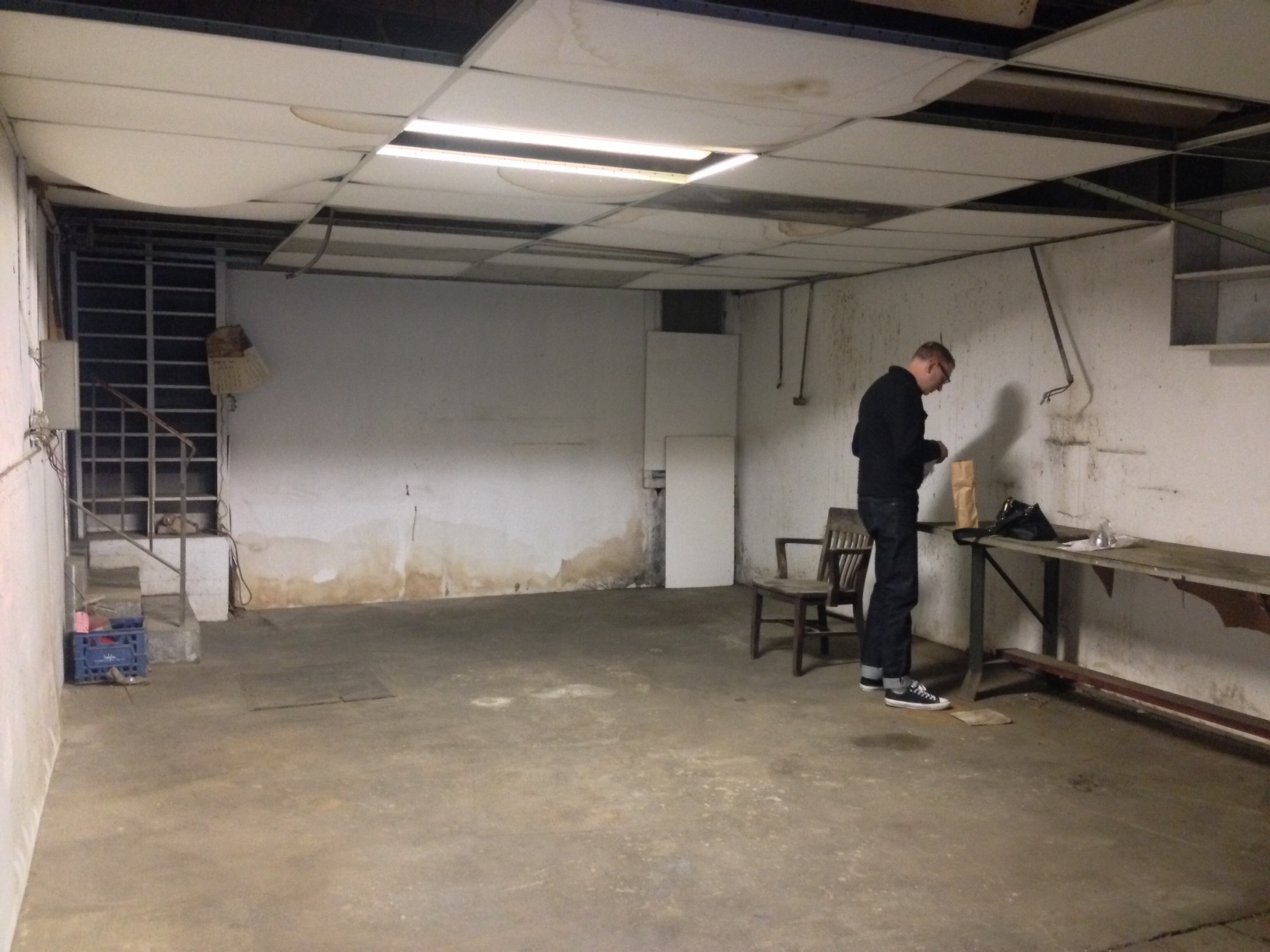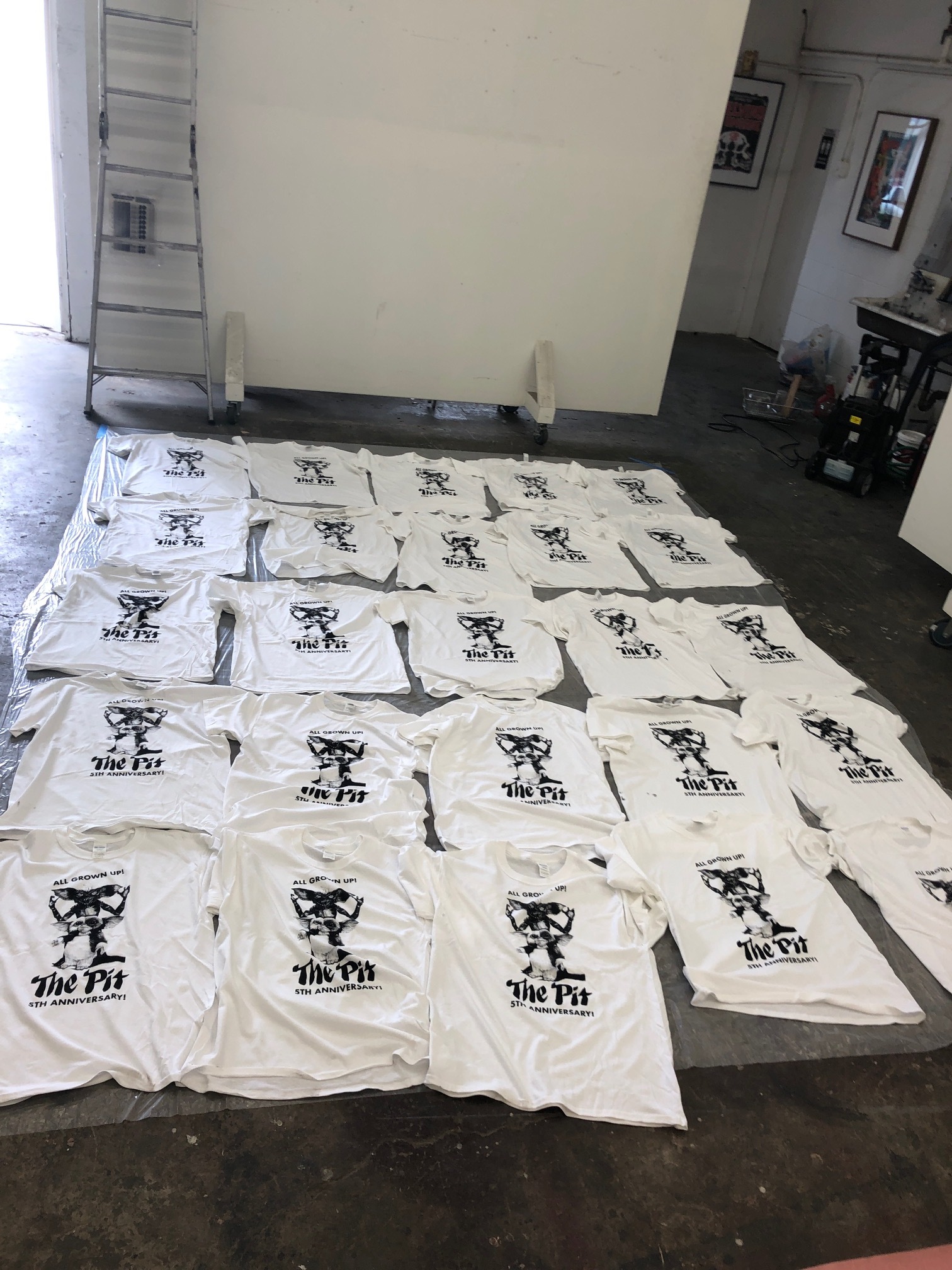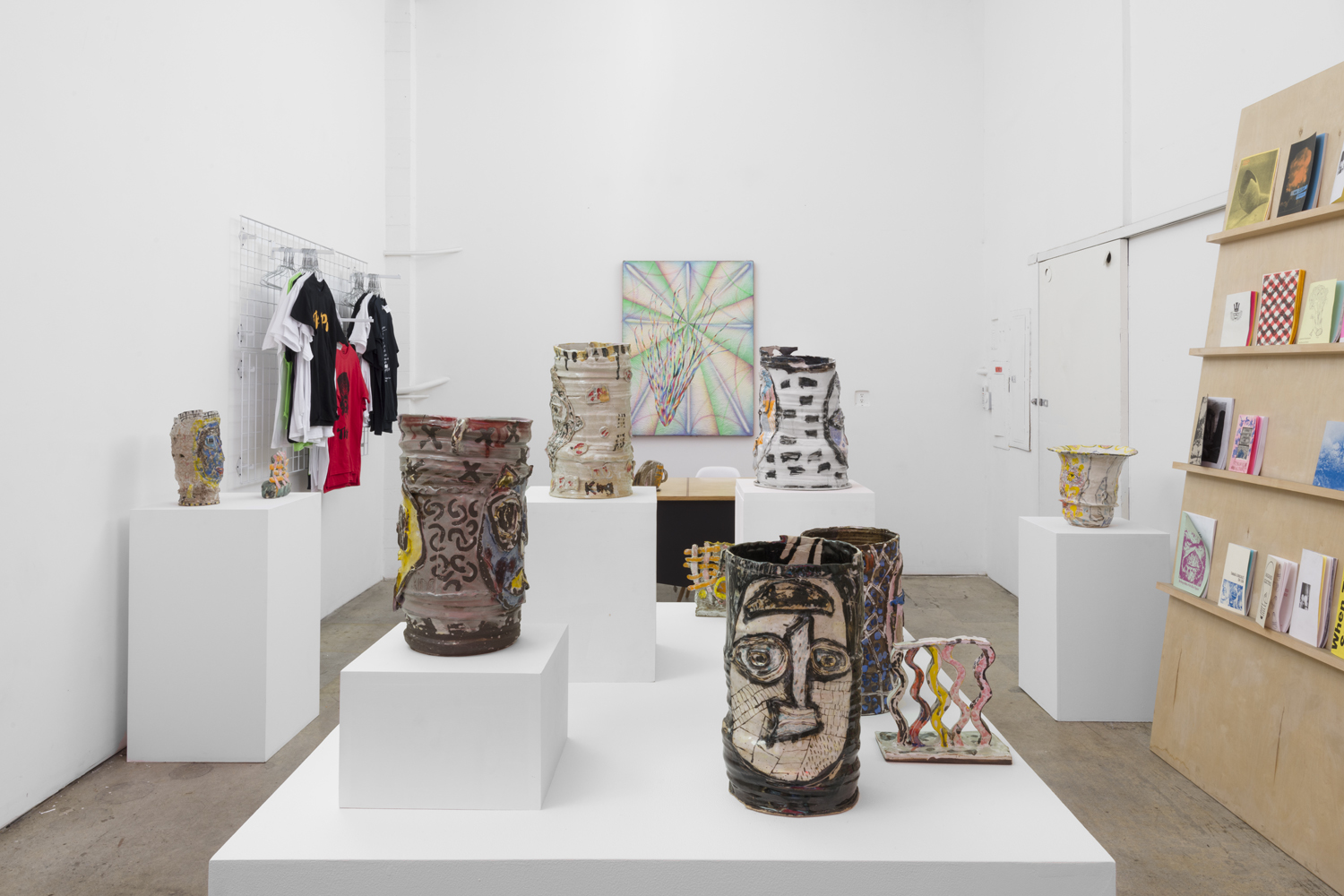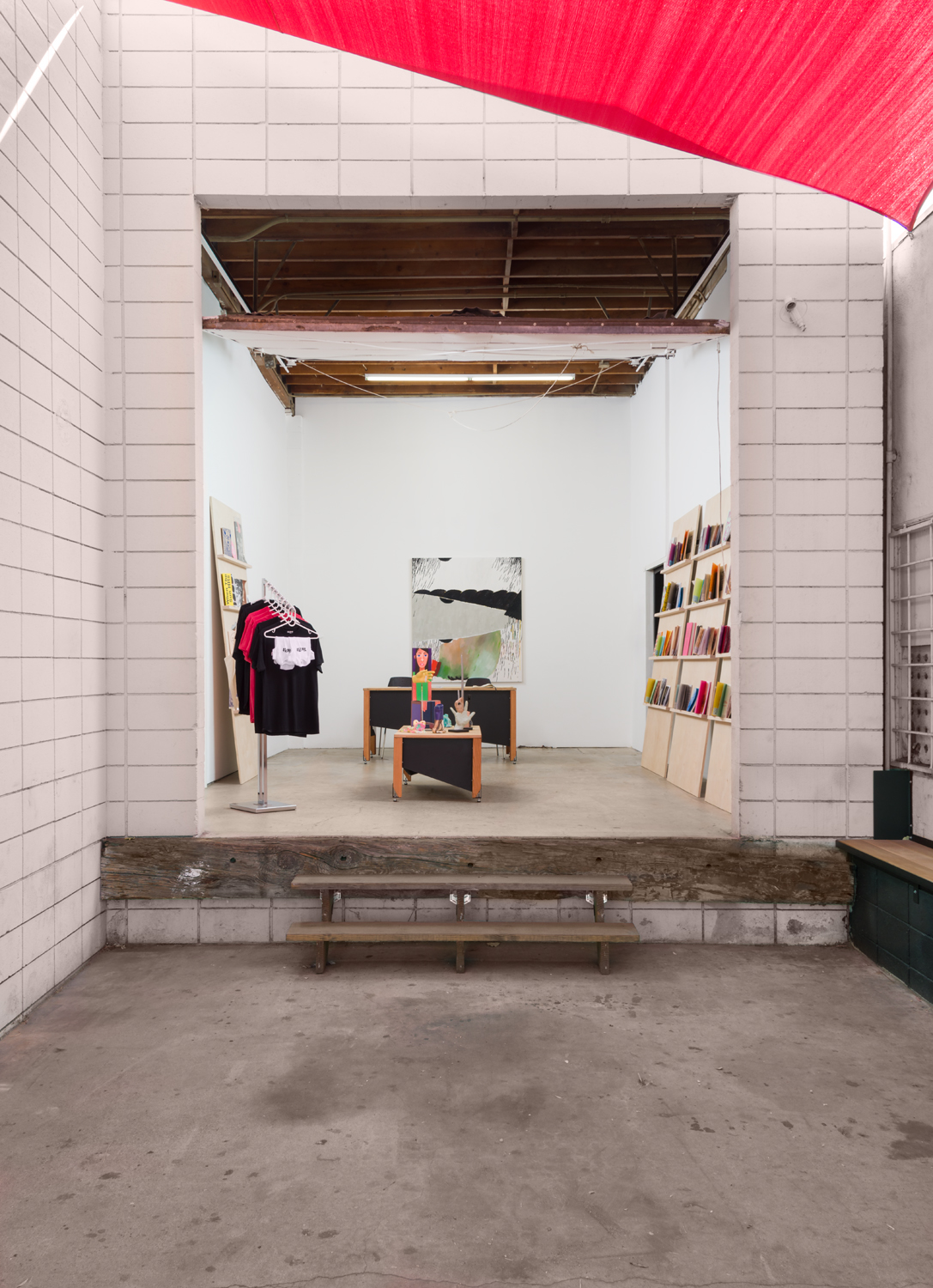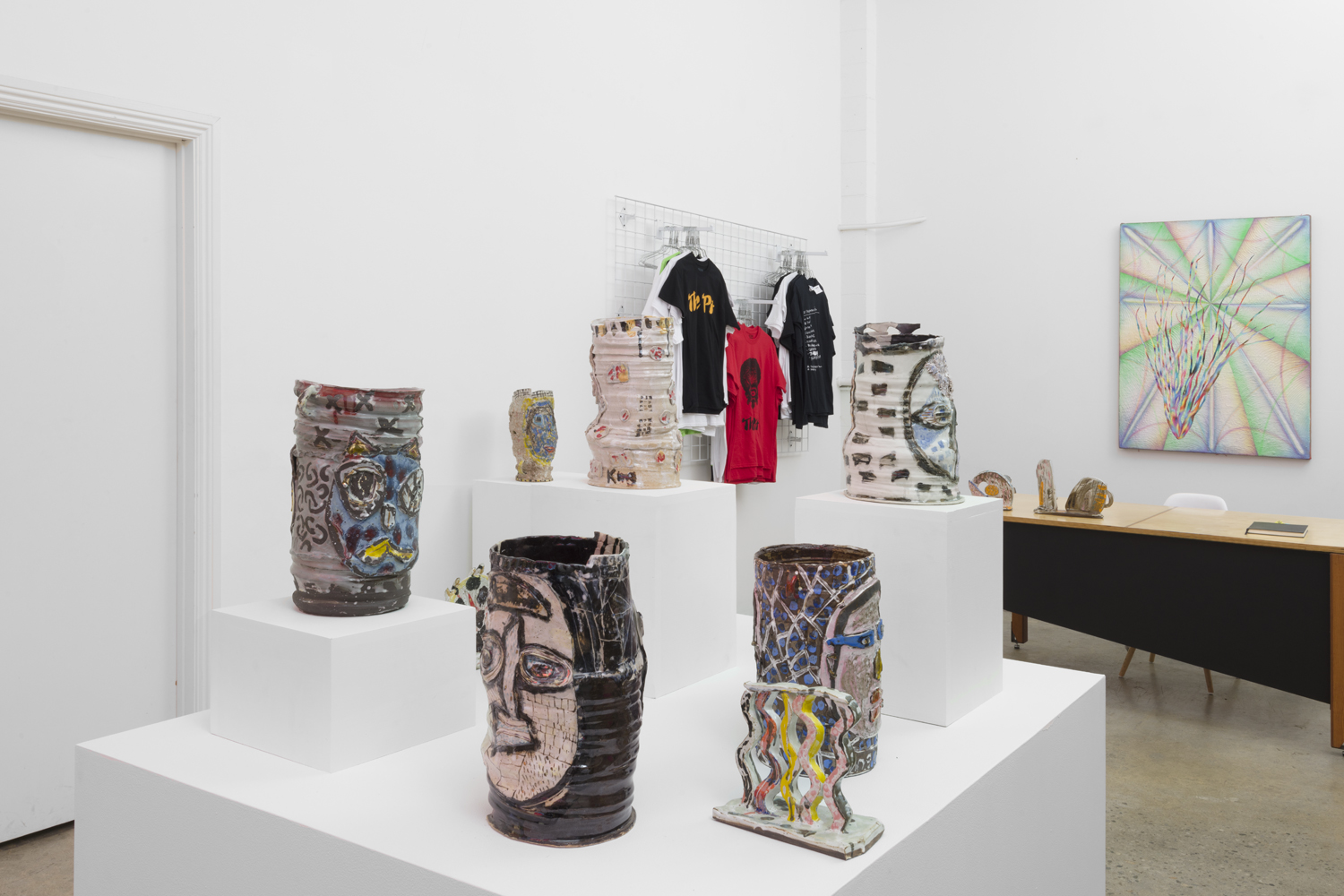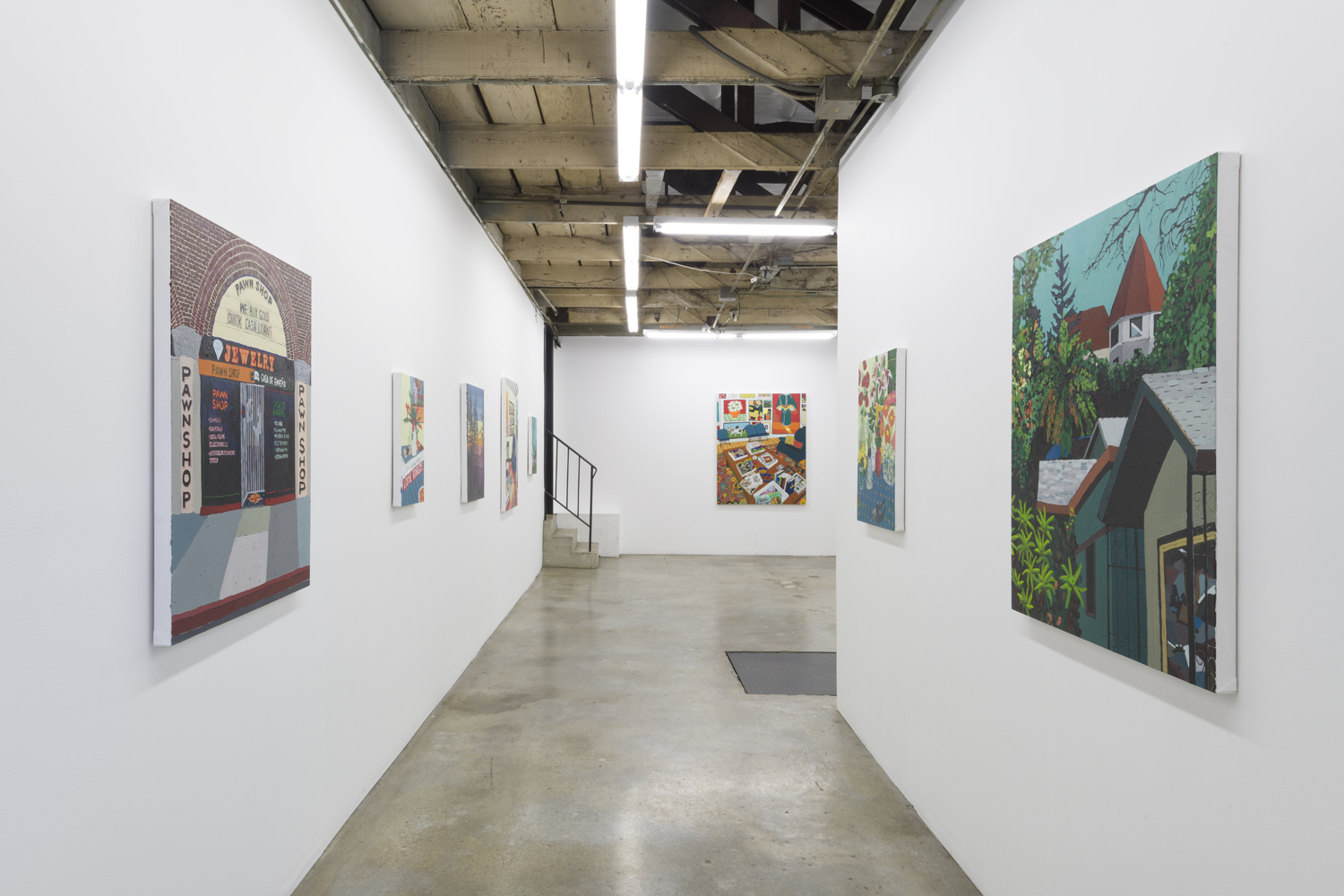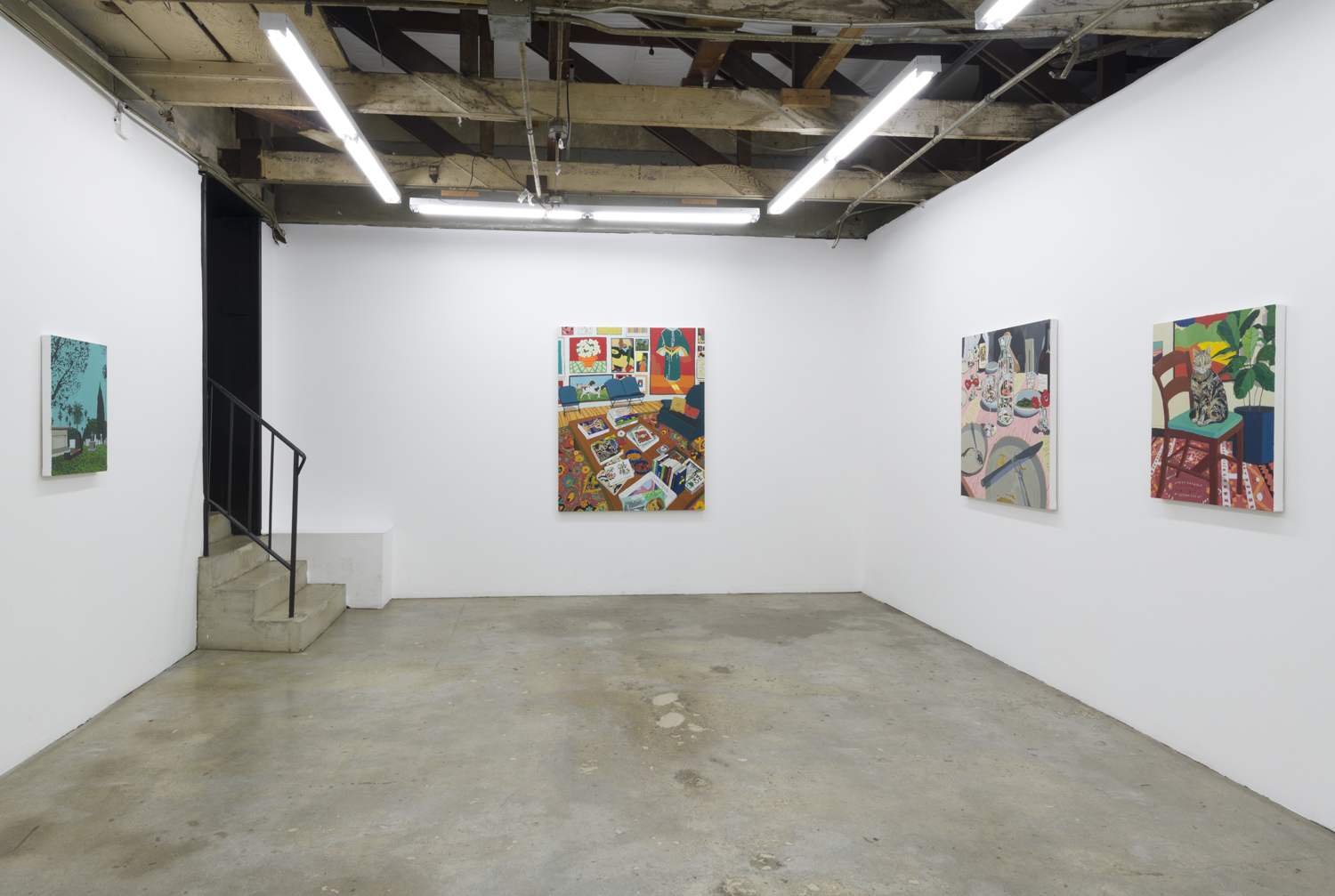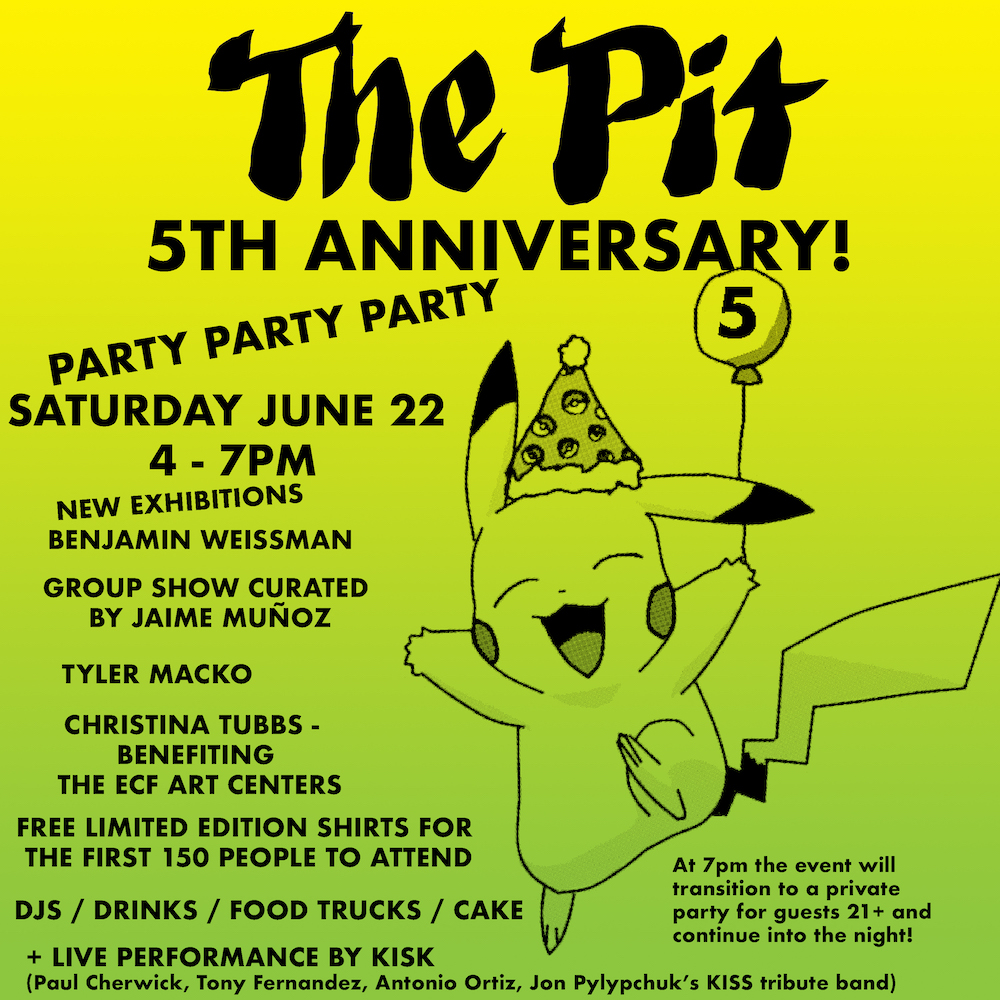Interview By Agathe Pinard
Photographs courtesy of Adam Miller
While most newly created galleries couldn’t make it through the hard reality of the art market in Los Angeles and pass the fateful milestone of the first two years, The Pit is about to celebrate its five year anniversary this month. I met with the co-founders and artists, Adam Miller and Devon Oder, for a chat at the gallery’s location in Glendale. As they gave me a tour of the three gallery spaces that make up The Pit , Adam stopped to point out a literal pit on the ground. “Here is The Pit,” he told me. In the forty-five minute long conversation that followed, we retraced the history of The Pit, talked about the benefits of doing it yourself, and pictured LA’s forthcoming art scene.
AGATHE PINARD: Can you tell us a little bit about the artists you’re currently showing?
ADAM MILLER: In the main gallery is Hilary Pecis, she’s an LA-based painter, and this is her first solo exhibition in Los Angeles. In The Pit II is Dani Tull, he’s been working in Los Angeles for many years, and has exhibited internationally. He makes sculpture, installation, and paintings. Hilary’s work is more of a painter’s painter practice: depictions of still lives, snapshots from Los Angeles, moments of her daily life; whereas Dani’s work is more conceptual. A lot of his work deals with mysticism, new age philosophy, and religions. In the zine shop, we have ceramics by Jennifer King, also a Los Angeles-based artist. Finally, in the back gallery, otherwise known as “The Pit Presents,” we have a group exhibition that was organized by Left Field, a gallery from Los Osos, California.
AGATHE PINARD: I heard that before running a gallery you were a musician. Can you talk about that a little?
ADAM MILLER: I moved to Los Angeles in 2006 to get my MFA from Art Center College of Design in Pasadena; that’s where Devon and I met. Previously, I was living in Sacramento where I was involved in the music scene. I moved there when I was eighteen and was already playing in punk bands, and then I moved more into garage and ‘60s revival music. But there was a real DIY ethos in Sacramento. Everyone ran record labels, booked their own tours, organized shows in alternative venues like laundromats, old theaters, and backyards, people made their own t-shirts, etc.. So, when I was young, that’s how life was, and when I was in bands, oftentimes, I was the person who did all that.
DEVON ODER: Of course, he did. As you’ll find out, he gets a lot done. (laughs)
ADAM MILLER: I do a lot of things. That’s basically how I learned to silkscreen. We’d make our own t-shirts in the bathroom of our apartments. During the four or five years I was living there, I helped set up my band with a record deal in Germany, and we were able to tour Europe. When I was in that band, I played the bass and I got a deal with the company, so they were sending me free bass guitars to play while on the road and things like that. So, pretty early on, I realized the benefits of doing it yourself, being super active, and not waiting for people to discover you or do things for you.
AGATHE PINARD: Were you going to school at that time?
ADAM MILLER: During that period of time, I was studying at Sacramento State University majoring in graphic design with a minor in fine art. Which also comes into play because I did a lot of the graphic design for the bands. Now, I do it here for The Pit. After two years, I switched to major in fine art and started organizing art shows at warehouses and underground venues in Sacramento. My first art show was at Kevin Seconds’ coffee shop, from legendary punk band 7 Seconds. Since I didn’t write the music, I felt like there was a shelf life to playing in the bands. I just started feeling less fulfilled playing music because I wasn’t fully expressing myself, and I had less control over it. So, I dropped out of all my bands and decided to apply to grad school. Getting into grad school was my real initiation to the fine art world. In Northern California, there was a bigger sort of graphic, street art component that related to the music scene, so I had been more involved with that.
When Devon and I were in grad school, we really wanted to figure out the LA art scene. We weren’t dating yet, but we both started working for the artist Sterling Ruby. She was the first office employee and I was the second studio assistant. So, while she was doing a lot of logistical, behind-the-scenes stuff for his exhibitions, I was doing fabrication, shipping, and installation while finishing grad school.
We finished grad school in 2008, the economy collapsed, a lot of the galleries in Los Angeles went under. So, I just kind of fell back on the way I was doing things when I was in bands. I started finding alternative spaces around Los Angeles and I would curate a group show. At that time, I’d put my own work in the show, and people were critical of that choice because hardly any artists were doing it. And every time I organized a show, I would make a zine and we would silkscreen the covers.
DEVON ODER: And it was also about extending our community. When you’re in graduate school, you’re in a super tight bubble, and then when you get out, you’re in your studio and you’re kind of twiddling your thumbs. The shows were really this great way to do a ton of studio visits and expand our world.
ADAM MILLER: Devon worked for Sterling Ruby until we opened the gallery in 2014. I worked for him until 2011, and then I decided I wanted my day job to be completely out of the art world. So, the other side of me as a person is that I’m involved in animal rights activism, so I worked for PETA in their grassroots campaigns for five years.
DEVON ODER: And he kept being like, “Let’s open our own space, let’s open our own space!” And at the time, it freaked me out.
AGATHE PINARD: So how did the idea of creating the gallery finally come together?
ADAM MILLER: It was a mix of things. We had done a lot of these shows for like five years and there weren’t many artist-run spaces still in operation in Los Angeles at the time. In 2013, Laura Owens opened 356 Mission, and that was radically inspiring. I think that’s when I was like, “I want to open a space.” I was so inspired to see an artist of her stature taking control of her own career, doing things for the community, for other artists to do things beyond just their own studio, their own practice, their own career, but to think more expansively about what an artist can do for the greater LA art community. Seeing someone just do it, and really shake off the judgment that people had about an artist showing their own work—that you shouldn’t organize your own shows— … Just get rid of these old ideas of what artists should, and shouldn’t do, and just be like, “I’m just gonna do it, and fuck it.” I thought it was so amazing and we started to look for a space about six months later.
DEVON ODER: So, we had this building as our studios, the part that you’re in right now, and we kept on thinking, “If we open our own space, how are we going to do that with day jobs, with our studio practice, and then another lease?” All of these things were adding up. Then, we were talking to our landlord about some ideas that we had and he was like, “Well, I’ve got these garages and I’ve just had my junk in them for over twenty years. You can have them if you clean them up.”
ADAM MILLER: It took us nine months to remodel and fix up the space; it was really crazy. The building had been a cabinet maker’s business at some point. So all the walls were covered in cabinetry and pockets of storage stuff that had just been gathering dust, and there was a dropped ceiling, broken windows, molded walls. It was a big undertaking.
DEVON ODER: We were wondering if this even could turn into a nice, pretty gallery?
AGATHE PINARD: You’d have to be pretty imaginative.
ADAM MILLER: It was 2013 when we started building the gallery. Most other galleries were still in Culver City, Hollywood, and Downtown was the new place where galleries were cropping up, but no one was located as far east as us. So that was another thing; we wondered if anyone would ever even come here.
DEVON ODER: When we opened it wasn’t a commercial gallery; it was a real artist project space. We did group shows curated by us, as well as by other artists. We did that for a couple of years.
ADAM MILLER: Yeah, we were several years in before we even had any public hours. I think we did two years of appointment-only.
AGATHE PINARD: At the beginning, in 2014, The Pit was a project space for wide-ranging group shows. Five years later, The Pit now has three galleries and a zine shop. Can you talk about the evolution of the project?
ADAM MILLER: We’ve slowly been able to take over more and more of the building.
DEVON ODER: Adam’s whole motto is if there is any available space you need to do something with it.
ADAM MILLER: What happened with The Pit II is that someone living across the street had a fancy car and just stored it in there. Every day that we would be here working he would pull it out and wash it in front of the gallery. It was a really funny scenario. This older guy would take his shirt off and wash the car, wax it, and stuff. Anyways, eventually he sold the car and didn’t need the space anymore.
DEVON ODER: And we always said right when we met him: “if you ever want to give up that garage, we’ll take it.”
ADAM MILLER: The first Pit II show opened in February 2015, so we were a year and a half in. That was the first time we ever did a solo show. We had only done group shows up to that point. That was a big moment for us because it really shifted the direction of the gallery. We started finding that working with one artist for a longer period of time on a solo project was so rewarding. Doing group shows was such a different experience. Group shows are really, really fun, but when you work with a friend, or someone who becomes a friend, you help them realize this vision; this big thing for their career—which is a solo show. It just feels like such a monumental thing in an artist’s life and it just feels more collaborative. Then somewhere along the line we started doing art fairs and became more commercial, started selling things, and I was able to leave my day job at a certain point.
AGATHE PINARD: The Pit Presents, one of the exhibition spaces, hosts galleries from other cities in a series of residencies and swaps. Can you talk about the initiative behind it?
ADAM MILLER: The back gallery (The Pit Presents) was three single car garages that we took over. A laundromat was using them for storage. The landlord asked if we’d want to take another chunk of the building and we snatched them up because, in my mind, if any space is available we should do something interesting with it.
DEVON ODER: We had no plans on expanding at that point.
ADAM MILLER: To be frank, at the time, we weren’t making enough sales in order to take on more overhead. So, we thought let’s just remodel it and we’ll rent it to another gallery. Then we’ll have a neighbor, and we can have shared openings and parties together. That was our initial idea. So we built it out, made it really nice, and started looking for someone to rent it. We got the space in 2017, and September 2018 was the first show. We were contacting people about renting out the gallery and we were speaking to a friend of ours who runs a gallery in Mexico City, who had an idea to run it as a collaborative. So he and four other gallerists from Latin America rented the space, and they called it Ruberta, which is the name of the street that we’re on. Each gallery got to do one show throughout the year. During that time The Getty was doing the Pacific Standard Time: LA/LA initiative, which had an emphasis on Los Angeles and Latin American connections in contemporary art. They rented the space, created Ruberta, and then their exhibitions and projects were promoted through the Getty and associated with Pacific Standard Time. So, it was a really amazing thing. That was only going to be one year. It ended last summer and we were trying to think of what to do with the gallery moving forward. I’m the primary salesperson, and we don’t really have the staff or manpower to fully program and sell a third space year round. We were trying to think about what was successful with Ruberta and how to start doing something similar, but in-house. So, basically we could insure it, staff it, and have a little more control. An issue with that was that they were all out of town, and had very limited hours. People were constantly asking us to open it up and we were uncomfortable doing that because it wasn’t our space, and we couldn’t speak intelligently about all the art, all the time.
That’s when we decided to do The Pit Presents, which is almost like a residency. We invite other galleries, whom we select, they put on a show, they program it, and they sell it, in most cases.
AGATHE PINARD: The art market being what it is right now, which aspects of founding a gallery have come most naturally, and which have been the most difficult?
ADAM MILLER: Well, the financial aspect is probably the most difficult. The best part is working with the artists and having a platform to support them. It will always be my favorite thing about owning a gallery.
DEVON ODER: The hardest part is being a business person.
ADAM MILLER: We’ve had to figure out how it worked. I think we have a different business model than most galleries. To be frank, that’s why we’re in Glendale: keep our overhead as low as we possibly can—and part of that is being outside of the normal gallery hubs. That’s why we now do so many shows at a time. We’re always trying to think outside the box. I would say that a normal gallery’s business model is to have a really nice space with fairly high overhead, and then do one show at a time of pretty expensive artworks, and depend on selling enough of that to cover everything. That’s the opposite of us. We keep it as low as we can, and we have lots of different opportunities for sales at various price points. We also sell shirts, artist books, limited editions, and host a lot events to keep people coming back to the shows and spend time in the zine shop.
DEVON ODER: Which allows us to be able to keep doing experimental things that might be more difficult to sell.
ADAM MILLER: You have to offset those with other things and figure that out. Budgets and profit/loss reports… that’s the not fun part, but it’s an important part that you have to learn.
AGATHE PINARD: How does an artist-run gallery compete with, and cohabitate with, much larger, blue-chip galleries, and such? What’s your relationship to them?
ADAM MILLER: Our roster of represented artists focuses primarily on emerging artists, but we work with a fair amount of larger, mid-career artists. So, usually, when we work with a bigger artist, we’re trying to see how we can collaborate with their bigger galleries to make it successful for everyone. We do really well with getting press for artists; they’re able to do more experimental projects that they might not be able to do in a bigger space that has a different type of overhead.
When we work with a bigger artist that’s been showing in a bigger gallery, I almost feel like we become their PR machine. Ideally, we’ll get them a lot of press. We have done quite well with certain artists, where they’ve been showing at great galleries, but maybe things have slowed down a little bit, and then we’ve been able to do a show with them and get them press by really pushing things hard on social media and through our networks. And the year after that, we’ll see that they have two or three shows with different galleries and they’re being taken to different fairs. Not that we are exclusively responsible for that, but I think we can help re-kickstart things and get a different audience to look at the work.
DEVON ODER: And then, we get to work with some of our idols; people we admire. That’s been so exciting.
AGATHE PINARD: You just participated in the first ever Frieze Art Fair in Los Angeles earlier this year. What was the experience like?
ADAM MILLER: It was an amazing experience for us, really great. It felt like a real validating moment—being one of the artist-run spaces. We were by far one of the smallest galleries there. The reception was wonderful. We did incredibly well both in networking and sales. It was also super good exposure for the artists. From a sales point of view, this is the strongest year the gallery has ever had, and a lot of it goes back to starting the year off so strong with that fair.
DEVON ODER: For a young, small gallery like us, fairs are the trickiest thing ever because they’re so expensive to do and if they don’t work it’s hard to recover. But when it does work, it can be so beneficial. Frieze was invitational and we just felt very great being there. It had a good vibe, good energy.
ADAM MILLER: It really felt like the LA art scene was championing us a little bit, it was really nice. We felt like the underdogs who made it to the big leagues or something. As Devon was saying, for us one fair can be a quarter of the year’s overhead. So, if we take a big hit on a fair, it can completely screw us up financially for the year, so we have to be very careful.
DEVON ODER: The artists that we represent tend to be emerging, so we have to sell more pieces because the price points tend to be lower.
AGATHE PINARD: How do you envision Los Angeles’s artistic landscape in the future?
ADAM MILLER: I picture it continuing to spread out away from the hubs in Hollywood and Culver City and Downtown. Galleries will start being more independent, in terms of looking elsewhere for lower overhead, rather than clustering together. I feel like when galleries cluster together it ends up driving up the rents in those neighborhoods, and eventually they leave looking for new spaces, and in the process a number of the galleries will close because it’s expensive to get a new space and move your business. I hope that there will continue to be more artist-run spaces. There are a plethora of young artist-run spaces now, which is amazing, and I hope that more will continue to open. We need more new galleries too, not just artist-run spaces, in particular we need more smaller galleries.
DEVON ODER: What’s so exciting now is that I feel like there are so many artist-run spaces again. So many artists are doing interesting things; it feels very active. Los Angeles just feels so active and free. People are opening spaces wherever. There’s artist-run spaces opening in Alhambra, Pasadena, everywhere. That’s exciting, it creates more opportunities for artists and allows for more diverse practices to thrive.
AGATHE PINARD: I also feel like the DIY movement that Adam was talking about in Sacramento is going strong right now in LA. I have friends opening mini art galleries in their backyard shed; they just remodeled the whole thing and made a tiny gallery that can maybe fit five or ten people at the same time.
DEVON ODER: Yes, if you’ve got the space, just use it! I love apartment galleries… just utilizing the space, just getting the work seen, and having that accessibility is really great.
AGATHE PINARD: What’s coming up next for The Pit?
DEVON ODER: Our five-year anniversary is next month, so we’re throwing a huge party. We’ll have a solo show by Benjamin Weissman in the main space, who is an artist that we’ve known and loved for years. He taught both of us at Art Center and we now represent him at The Pit. In the Pit II, Jaime Muñoz will be curating a group show. Tyler Mako will be in The Pit Presents. In our zine shop, we will be doing a solo exhibition by Christina Tubbs which will also be a benefit for the Exceptional Children’s Foundation Art Centers. The ECF Art Centers are a series of four professional art studios located across Los Angeles County that create artistic opportunities for artists with developmental disabilities. We are very excited to be able to support this amazing non-profit and to showcase the work of one of their talented artists.
ADAM MILLER: At the party, we will have a performance by KISK, a KISS tribute band, which includes the artist Jon Pylypchuk. He is a good friend of ours and a supporter of the gallery from the beginning.
DEVON ODER: He was in our third show here at the gallery. He’ll be performing, we’ll have food trucks, our friends will be DJing, so please come!


